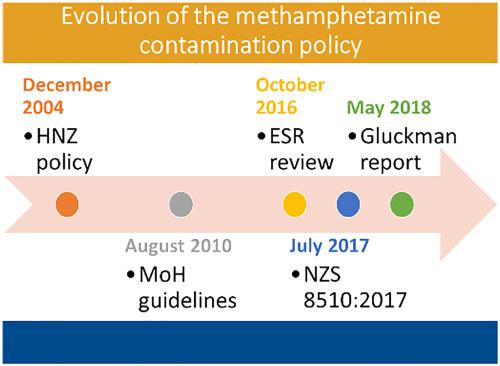当前位置:
X-MOL 学术
›
Drug Test. Anal.
›
论文详情
Our official English website, www.x-mol.net, welcomes your
feedback! (Note: you will need to create a separate account there.)
Investigating the New Zealand policy response to methamphetamine-contaminated houses.
Drug Testing and Analysis ( IF 2.6 ) Pub Date : 2020-03-09 , DOI: 10.1002/dta.2782 Claudia Denisse Sanchez Lozano 1 , Chris Wilkins 1 , Marta Rychert 1
Drug Testing and Analysis ( IF 2.6 ) Pub Date : 2020-03-09 , DOI: 10.1002/dta.2782 Claudia Denisse Sanchez Lozano 1 , Chris Wilkins 1 , Marta Rychert 1
Affiliation

|
The contamination of houses from clandestine methamphetamine manufacture emerged as an issue in New Zealand in the early 2000s. This perspective reviews and discusses the series of policies developed to address methamphetamine contamination in New Zealand houses over a 15‐year period, ending with the reversal of the established policy approach in 2018. The policies addressing methamphetamine contamination of New Zealand properties were influenced by a range of sources including overseas scientific guidelines, local scientific reviews, public housing agency policies, and the local methamphetamine testing industry. A post‐remediation methamphetamine level of 0.5 μg/100 cm2 was initially implemented in 2010, leading to the termination of public housing tenancies, suspensions from the public housing list, and financial charges for decontamination on public housing tenants. Subsequent reviews of the policy led to some increase in the thresholds (up to 1.5–3.8 μg/100 cm2) and the adoption of less punitive sanction processes. A scientific review in 2018 recommended a substantial threshold increase to 15 μg/100 cm2 (a 30‐fold increase on the 2010 standard), resulting in HNZ initiating a plan to compensate previously sanctioned tenants. Overreliance on the “precautionary principle”; strict interpretation of scientific guidelines; and the public housing agency's “zero tolerance approach” to drug use, contributed to an overly punitive policy approach to methamphetamine contamination in New Zealand that negatively impacted vulnerable public housing tenants, landlords, and property owners. Investigation into the extent that all possible influences had on the development of the policies, as well as the consequences of their implementation, should be undertaken.
中文翻译:

调查新西兰对受甲基苯丙胺污染的房屋的政策反应。
2000年代初,在新西兰出现了秘密制造甲基苯丙胺造成的房屋污染问题。该观点回顾并讨论了为解决新西兰房屋中的甲基苯丙胺污染而在15年内制定的一系列政策,最终于2018年逆转了既定的政策方法。针对新西兰财产中甲基苯丙胺污染的政策受到了以下因素的影响:各种来源,包括海外科学指南,当地科学评论,公共住房机构政策以及当地的甲基苯丙胺检测行业。补救后的甲基苯丙胺水平为0.5μg/ 100 cm 2该法案最初于2010年实施,导致终止了公共住房租赁,暂停了公共住房清单以及对公共住房租户进行净化处理的财务费用。随后对该政策的审查导致阈值有所提高(最高1.5–3.8μg/ 100 cm 2),并采用了惩罚性较小的制裁程序。2018年的科学审查建议将阈值大幅提高至15μg/ 100 cm 2(比2010年标准增加了30倍),导致HNZ发起了一项计划,以补偿先前受制裁的租户。过度依赖“预防原则”;严格解释科学准则;公共住房机构对毒品使用的“零容忍方法”促成了新西兰对甲基苯丙胺污染的过度惩罚性政策方法,对脆弱的公共住房租户,房东和财产所有人产生了负面影响。应调查所有可能影响政策制定的程度及其实施的后果。
更新日期:2020-03-09
中文翻译:

调查新西兰对受甲基苯丙胺污染的房屋的政策反应。
2000年代初,在新西兰出现了秘密制造甲基苯丙胺造成的房屋污染问题。该观点回顾并讨论了为解决新西兰房屋中的甲基苯丙胺污染而在15年内制定的一系列政策,最终于2018年逆转了既定的政策方法。针对新西兰财产中甲基苯丙胺污染的政策受到了以下因素的影响:各种来源,包括海外科学指南,当地科学评论,公共住房机构政策以及当地的甲基苯丙胺检测行业。补救后的甲基苯丙胺水平为0.5μg/ 100 cm 2该法案最初于2010年实施,导致终止了公共住房租赁,暂停了公共住房清单以及对公共住房租户进行净化处理的财务费用。随后对该政策的审查导致阈值有所提高(最高1.5–3.8μg/ 100 cm 2),并采用了惩罚性较小的制裁程序。2018年的科学审查建议将阈值大幅提高至15μg/ 100 cm 2(比2010年标准增加了30倍),导致HNZ发起了一项计划,以补偿先前受制裁的租户。过度依赖“预防原则”;严格解释科学准则;公共住房机构对毒品使用的“零容忍方法”促成了新西兰对甲基苯丙胺污染的过度惩罚性政策方法,对脆弱的公共住房租户,房东和财产所有人产生了负面影响。应调查所有可能影响政策制定的程度及其实施的后果。











































 京公网安备 11010802027423号
京公网安备 11010802027423号